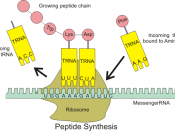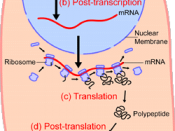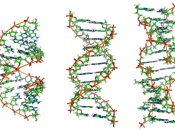Protein synthesis is one of the most fundamental biological processes. To start off, a protein is made in a ribosome. There are many cellular mechanisms involved with protein synthesis. Before the process of protein synthesis can be described, a person must know what proteins are made out of. There are four basic levels of protein organization. The first is primary structure, followed by secondary structure, then tertiary structure, and the last level is quaternary structure. Once someone understands the makeup of a protein, they can then begin to learn how elements can combine and go from genes to protein. There are two main processes that occur during protein synthesis, or peptide formation. One is transcription and the other is translation. Although these biological processes slightly differ for eukaryotes and prokaryotes, they are the basic mechanisms for which proteins are formed in all living organisms.
There are four main levels of a protein, which make up its native conformation.
The first level, primary structure, is just the basic order of all the amino acids. The amino acids are held together by strong peptide bonds. The next level of protein organization is the secondary structure. This is where the primary structure is repeated folded so that it takes up less space. There are two types of folding, the first of which is beta-pleated sheets, where the primary structure would resemble continuous spikes forming a horizontal strip. The second type of folding is an alpha helix, which goes vertically forming a wavy line. An alpha helix is in the same shape of one strand of DNA. These new formations are held together by hydrogen bonds. The third level is the tertiary structure. The tertiary structure of a protein is a contorted secondary structure being twisted and folded all out of shape to form...


